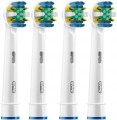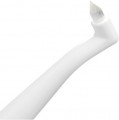Purpose
The attachment type is crucial because it specifies the device for which it is designed. Nozzles for electric toothbrushes and irrigators are manufactured using distinct technologies and are not interchangeable. Furthermore, even brush heads from the same manufacturer may not universally fit toothbrushes or irrigators from that same brand. Therefore, it's essential to check the "Compatibility" section in the nozzle description, which provides a list of all devices compatible with that specific model.
— For a toothbrush. Heads for electric toothbrushes may differ in shape, cleaning technology and functional purpose. Usually, one nozzle is aimed at solving a specific task: daily brushing,
whitening,
deep brushing, etc. There are no multifunctional nozzles, you need to purchase several nozzles to achieve different goals.
—
For the irrigator. These devices clean teeth with a pulsating jet of water and can be more effective than classic toothbrushes for many tasks. For example, irrigators are better at cleaning hard-to-reach places (interdental space, braces), gum massage, etc.
—
For the dental center. Dental centers are a complete system with the functions of the irrigator and toothbrush described above. It can be as two separate devices or as one with interchangeable heads. Anyway, tips must be changed in both
...types of dental centers.Number of nozzles
The product package may contain
multiple nozzles, typically in sets of
2 or even
3 or more. These nozzles can either be identical or serve different purposes, such as daily cleaning, whitening, or gum massage. It's crucial to carefully read the product description, keeping in mind that it reflects the standard factory equipment. However, stores may make modifications, such as adding extra components to the basic
package with just 1 nozzle. Therefore, it's advisable to confirm the number and type of nozzles with the store manager before making your purchase.
Head type
The shape of the head directly affects its characteristics and cleaning efficiency. This parameter must be considered in conjunction with the cleaning technology.
—
round. Round brush heads are more commonly used on electric toothbrushes with reciprocating brushing technology. This shape allows you to increase the efficiency of cleaning hard-to-reach places (interdental space, for example), and is also considered one of the best options for sensitive teeth. But at the same time, the area of the brush itself is small, and therefore the process of brushing your teeth takes more time.
—
oval. The most familiar shape of a toothbrush head, well known to users from classic, non-electric toothbrushes. Offers more surface area and more intensive treatment of the teeth, but the treatment is rougher and may not be the best option for sensitive teeth. However, the latter applies to toothbrushes with reciprocating sweeping technology, while models with
sonic cleaning technology do not have these drawbacks at all.
—
combined. These heads are formed from two parts: one is round and the other is oval. Thus, the manufacturer tries to combine the advantages of two different types. Such a solution is not very popular, electric toothbrushes are practically not equipped with such nozzles as regular ones, but they can always be
...purchased as an additional, removable nozzle.Brushing technology
At the heart of each of the technologies described below is the way the bristles move, which is used to clean the teeth. Note that this parameter is largely related to the shape of the nozzle head (see "Shape of the toothbrush head").
—
reciprocating-rotating. Nozzles that support this technology are typically small and have a round head shape. When in use, the circular arrangement of bristles rotates rapidly in either direction. This technology offers a gentler cleaning experience, which can be crucial for those with sensitive teeth. However, it's important to note that effective tooth brushing may take a bit longer using this method.
—
reciprocating-sweeping. The toothbrush head moves in a side-to-side sweeping motion, resembling a broom. This technology offers more effective cleaning compared to the previous option, but it can be too intense for those with sensitive teeth. Typically, the nozzle has an oval shape with a larger surface area. However, when it comes to hard-to-reach areas like the interdental spaces or braces, these brushes may not perform as well.
—
pulsating. This is not a standalone technology but rather an enhancement to the reciprocating-rotating or reciprocating-sweeping technologies. Nozzles of this kind enable rapid back-and-forth movement of bristles within the head. When combined with one of the previously describe
...d technologies, this feature boosts cleaning efficiency and facilitates the "3D cleaning" function (as outlined in the "Features" section).
— sound. Electric toothbrush heads using sonic cleaning technology involve bristle movement at a frequency of tens of thousands of vibrations per minute, which is in the audible sound range. This advanced technology offers both effective cleaning and minimal risk of damaging tooth enamel.Application
Depending on the design, different heads for electric toothbrushes can be used for different tasks. Usually, the versatility of toothbrushes is achieved by just the right set of nozzles.
— Daily brushing (2D). This toothbrush head can be a good solution for routine, daily brushing. Provides the movement of the bristles according to one of the above technologies: reciprocating-rotating, reciprocating-sweeping, sonic or ultrasonic.
— Whitening. The nozzle is designed to whiten teeth, remove dense plaque, restore natural colour and shine. But it is important to understand that such a procedure is associated with intensive processing, which can adversely affect tooth enamel, and therefore it is recommended to use specialized nozzles for whitening.
— Deep brushing. It implies the possibility of intensive cleaning of hard-to-reach places, such as braces, implants or interdental spaces. Note that the features of the implementation of this function may differ depending on the specific nozzle model.
Head wear indicator
These nozzles provide the ability to timely
notify the user of the need to replace the nozzle. Usually, this is realized through the use of a special colour of the bristles, which discolors along with the general wear of the nozzle. Thanks to this, the user can monitor the condition of the nozzle and replace it in time.
Compatibility
Before purchasing, it's crucial to check the list of electric toothbrushes or irrigators (as mentioned in the "Type" section) with which the nozzle is compatible. It's worth noting that being from the same brand doesn't automatically ensure compatibility between the toothbrush and the selected nozzle. This aspect should be carefully reviewed before making a purchase decision.

